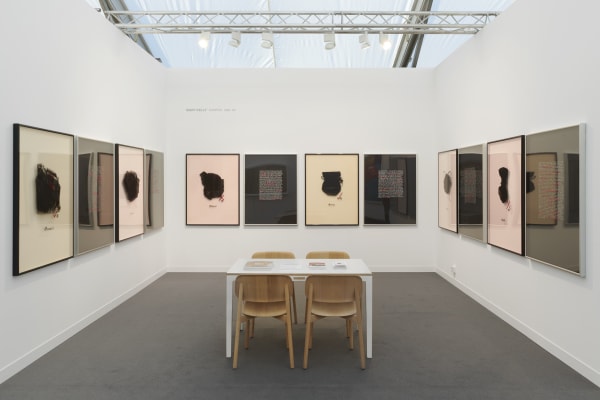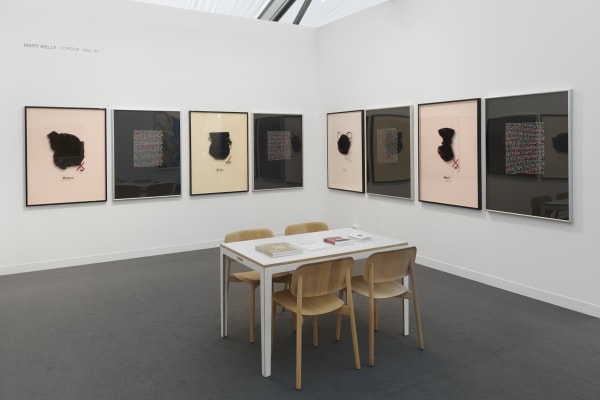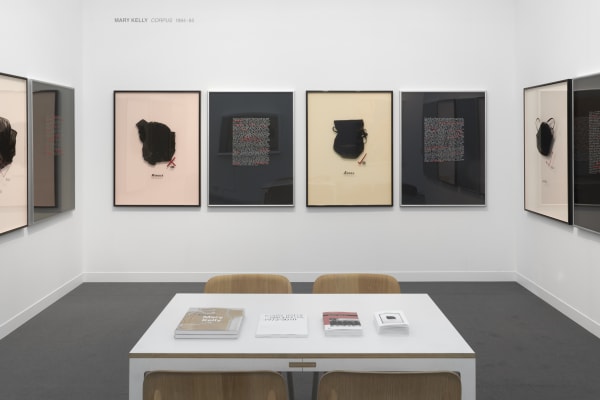‘In Interim, I've problematized the image of the woman not to promote a new form of iconoclasm, but to make the spectator turn from looking to listening. I wanted to give a voice to the woman, to represent her as the subject of the gaze.’
- Mary Kelly
At Frieze London 2018, Pippy Houldsworth Gallery will present Mary Kelly’s Interim, Part I: Corpus(1984-85) as part of Social Work, a special section of the fair dedicated to female artists who challenged the male-dominated art market of the 1980s. Subject of a major solo exhibition at the New Museum, New York in 1990, Corpus has since been described by Amelia Jones as ‘the single most important feminist artwork from the 1980s.' Over the past fifty years, Kelly has been a pioneer of conceptual art and contributed extensively to the discourse of feminism and postmodernism. The artist’s presentation at Frieze London will coincide with a solo show of new and unseen works at Pippy Houldsworth Gallery that will demonstrate Kelly's sustained engagement with questions of war and violence over the past fifty years.
Corpus is a work about identification. Whilst Kelly’s iconic Post-Partum Document (1973-79) unveils the heavily prescribed nature of motherhood, the female narrator in Corpus explores the stark, unknown terrain of middle-age life as she finds herself stranded between roles. The preliminary artwork for Corpus was recently acquired by the Centre Pompidou Foundation for the permanent collection of Centre Pompidou, Paris.
Corpus, the first section of a larger installation titled Interim, pairs images and panels of text (white on black, with phrases and parts of the images picked out with red acrylic) on reflective plexiglass in an arrangement of five groups. Each arrangement takes its title - Menacé, Appel, Supplication, Érotisme and Extase - from the nineteenth-century French neuropathologist J.M. Charcot’s attitudes passionelles, his classification of the hallucinatory phase of hysteria. The texts are hand-written, first-person accounts which explore how older women experience the body.
In the catalogue to the New Museum show, Marcia Tucker explains that for ‘three years before [Kelly] began to give form to the project, she kept a notebook - an archive, as she calls it - in which she recorded conversations she had overheard or engaged in with women who were responsible for launching, or had been affected by, the second wave of feminism - the women, in other words, of 1968. Arranging her notes in various forms, she offers us the opportunity to hear these women as they explore their experiences as wives, mothers, sisters and daughters, most of them from the vantage of middle age.‘
Each text is represented by an item of clothing (a jacket, a handbag, a pair of boots, a black nightgown and a white embroidered dress) arranged in increasing states of disarray. For instance, Kelly's narrative describes that the black leather jacket is the prop or armour worn by a woman in an attempt to signify being an ‘artist.’ The shadows cast by the photo laminates underscore the artist’s avoidance of figurative representation and strategic use of the indexical sign.
Mary Kelly (b. 1941) lives and works in Los Angeles. Over the past five decades, Kelly has addressed questions of sexuality, identity and historical memory. Her large-scale narrative installations include Post-Partum Document (1973-79), Interim (1984-89), The Ballad of Kastriot Rexhepi (2001), Circa Trilogy (2004-2015) and Love Songs (2005-07). Kelly first came to prominence with Post-Partum Document, a sociological study of the intersubjective relationship between mother and child. Exhibited in 1976 at the ICA in London, Kelly’s work proved scandalous for incorporating a selection of her son’s stained nappy liners within the installation.
Her work has been the subject of major solo exhibitions at the ICA, London (1976 and 1993); New Museum of Contemporary Art, New York (1990); Generali Foundation, Vienna (1998); Santa Monica Museum of Art (2001); Center for Contemporary Art, Ujazdowski Castle, Warsaw (2008); Moderna Museet, Stockholm (2010); Mary Kelly: Projects, 1973-2010, Whitworth Art Gallery, Manchester (2011); Pippy Houldsworth Gallery, London (2014) and Mitchell-Innes & Nash, New York (2017). Kelly was represented in the 1991 and 2004 Whitney Biennials, Whitney Museum of American Art, New York; Documenta 12, Kassel, 2007, and the 2008 Biennale of Sydney.
Kelly’s work is included in numerous public collections, including Tate, London; Centre Pompidou, Paris; Whitney Museum of American Art, New York; Hammer Museum, Los Angeles; Moderna Museet, Stockholm; MOCA, Los Angeles; Arts Council Collection, UK; Muzeum Sztuki, Łódź; Museum of Contemporary Art, Chicago; Museum of New Zealand Te Papa Tongarewa, Wellington; Whitworth Art Gallery, Manchester; New Museum of Contemporary Art, New York, and numerous others.
In 2017, the Getty Research Institute, Los Angeles, acquired Kelly’s archive. 2018 exhibitions featuring Kelly’s work include those at Whitney Museum of American Art, New York; Kettle’s Yard, Cambridge; Tate St Ives, Cornwall; Pallant House Gallery, Chichester; Murray Edwards College, University of Cambridge; Fitzwilliam Museum, Cambridge, and Tate Britain, London. Kelly is currently making a new, large-scale installation for Desert X, Coachella opening in early 2019.




